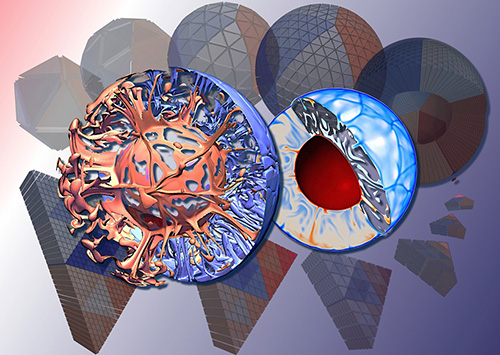ENVIRONMENT AND ENERGY
TERRA-NEO: Integrated Co-Design of an Exa-Scale Earth Mantle Modeling Framework
Principal Investigator:
Björn Gmeiner
Affiliation:
Universität Erlangen-Nürnberg (FAU)
Local Project ID:
her16
HPC Platform used:
JUQUEEN of JSC
Date published:
Mantle convection is a vital component of the Earth system. The relentless deformation taking place in the mantle by viscous creep has a far greater impact on our planet than might be immediately evident. Immense forces are at work in mantle convection cells: continuously reshaping Earth's surface, the mantle provides the enormous driving forces necessary to support large scale horizontal motion, in the form of plate tectonics and associated earthquake and mountain building activity.
At the same time the mantle induces substantial vertical motion in the form of dynamically maintained topography through lateral pressure gradients beneath tectonic plates. This vertical motion is perhaps the most spectacular manifestation of mantle convection - and its most defining and enduring impact upon the entire Earth system.
The computational simulation of mantle convection is a classical grand challenge application, requiring extremely fine spatial and temporal resolutions to represent the system accurate enough to allow for the use of realistic physical parameters. While the state of the Earth today is partly known from measurements and the study of geological formations, the state of the Earth in the past is largely unknown. Hence, to get a better understanding of the processes taking place deep inside the Earth, inverse computations are required. Thus the input parameters of the model must be reconstructed from its output. A typical example would be the determination of a past state of a model based on the present state. Such computations going backwards in time are extremely demanding, since small perturbations in the past can cause large differences in the present. Moreover, since the entire knowledge of the Earth's current state is from measurements, uncertainties with respect to the material composition or driving forces and their influence on the solution of the model equations need to be quantified, adding even more computational demand.
TERRA-NEO is an ambitious project to construct a next generation mantle circulation model that allows simulation-based breakthroughs in our understanding of the solid Earth. Current and future supercomputers can deliver the exceptional computational power needed for this research field.

Extreme-scale simulation of a buoyancy driven flow using a massively parallel multilevel approach. Copyright: © Universität Erlangen-Nürnberg, Lehrstuhl für Informatik 10
The scientific team consists of the following researchers:
U. Rüde, B. Gmeiner, M. Huber (FAU1)
G. Wellein, H. Stengel (RRZE2)
H-P. Bunge, M. Mohr, J. Weismüller (LMU3)
B. Wohlmuth, M. Hofmann, L. John, C. Waluga (TUM4)
1 Friedrich-Alexander-Universität Erlangen-Nürnberg (FAU)
2 Regionales Rechenzentrum Erlangen (RRZE)
3 Ludwig-Maximilians-Universität München (LMU)
4 Technische Universität München (TUM)
The simulations were executed on GCS supercomputer JUQUEEN of Jülich Supercomputing Centre.
The research is also funded by SPPEXA - German Priority Programme 1648: Software for Exascale Computing.
Dr.-Ing. Björn Gmeiner
Universität Erlangen-Nürnberg
Lehrstuhl Informatik 10 (Systemsimulation)
Cauerstraße 11, D-91058 Erlangen/Germany
e-mail: bjoern.gmeiner@fau.de